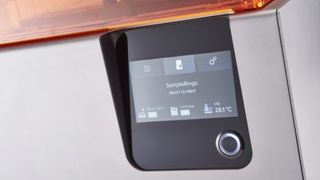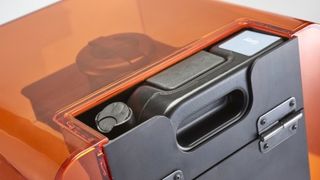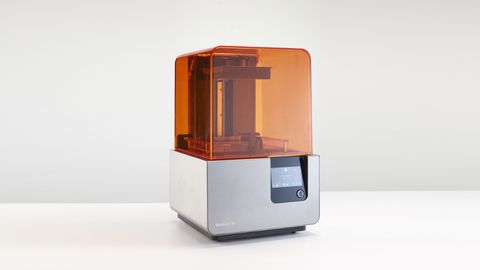Why you can trust TechRadar
Unlike the huge selection of materials available for FFM printers when it comes to resin there are far fewer options. However, the material types available for SLA are generally tailored for specific uses or have certain properties such as being flexible or tough.
This diversity of material type is in contrast to the huge variety of colours available with FFM filament and really does show that this printer is designed for use by businesses and high-end enthusiasts.
There is a standard resin type that is available in clear, black, grey and white. Other materials include those designed for casting, heavy use and even dental, not something you'd expect from a normal desktop 3D printer.

Commissioning the printer takes a good 20 minutes and once started it's best to wait with the machine just to check that everything is in order. Due to the design there really is little to go wrong and if you do try to print on an uneven surface the printer will alert you to level it using the small adjustable feet on the base.
Initial test prints showed that even at its lowest setting the Form 2 is capable of prints that equal if not better the vast majority of FFM printers at their highest quality, with only the Zortrax M200 coming anywhere close.
Once the print completes it can then be removed from the build plate. Unlike an FFM printer the process of print removal is a little more involved and time consuming requiring the build plate to be removed, print extracted and then cleaned in IPA or Acetone before being washed and then left to cure.
The whole process from start to finish can take about 24 hours for the print to fully harden but the end result is well worth it.
Alongside the printer FormLabs also produces a finishing kit and if you're thinking of investing it's well worth paying out a little more for this set.
The finishing kit includes two washing basins, a series of tools and a handle for the build plate that can be used when removing the prints.

Printing
As with the vast majority of new printers the Form 2 arrives with its own software: PreForm. Initially this software looks much the same as any other, but as you start to use PreForm it becomes quickly apparent that this offering is on another level.
On importing a 3D model the software will instantly be able to tell if there are any issues with the model and then it repairs them automatically. In testing we found that the software did an incredible job eliminating intersecting faces and repairing those that are missing without issue.
Once the model is repaired and loaded into the software you can quickly prepare it for print and add supports. During the test we found that placing the model diagonally across the build plate produced the best results and also made the prints easier to remove when ready.
A single button at the base of the interface shows you what material will be used to print and at what quality – if you click this a simple interface opens enabling you to change the settings.

As you flip through each of the materials you'll see that there are only a limited amount of options to ensure that you can only print within the tested limits of that material.
Then once you have selected the material and quality you can hit the print button. This will send the print across to the machine either through USB or Wi-Fi – then you'll see the job appear on the printer itself. To print you need to click the option to confirm and the printer will warm up and print.
Print times are slower than an FFM printer, but only by about 10-20% depending on the model. The major time drain is the clean-up of the model afterwards.

